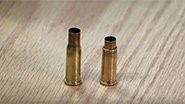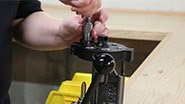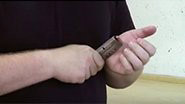More and more people are beginning to reload their own ammunition due to the cost savings associated with it. Reloading also provides the opportunity to customize your loads to meet your ammo needs. Whether you are a veteran reloader or a newbie to reloading, we have compiled a few tips and tricks to help you in your reloading endeavors in Reloading Tips and Tricks 2.0. For more helpful tips, take a look at our previous article Reloading Tips and Tricks.
When loading some handgun calibers that require a lot of neck tension, or calibers that use a wide range of bullet diameters, you may be required to size your new cases prior to the first loading to achieve proper bullet tension. When doing this, it is generally not necessary to full length size the brass; you can just adjust the sizing die up to the point where it is only sizing 3/8 to 1/2 inch of the case mouth. This will require much less force than full length sizing and will also save your brass from any unnecessary work hardening.
 When sizing bottleneck rifle cases, especially shorter length and thin walled cases like the .32-20, it is possible to crush the case if the expander is improperly adjusted. Most bottleneck sizing dies will have a case mouth expander on the decapping assembly which is used to set the ID of the mouth to achieve the proper bullet tension.
When sizing bottleneck rifle cases, especially shorter length and thin walled cases like the .32-20, it is possible to crush the case if the expander is improperly adjusted. Most bottleneck sizing dies will have a case mouth expander on the decapping assembly which is used to set the ID of the mouth to achieve the proper bullet tension.
The sizing die will size the case neck down enough that the ID is smaller than the expander. If the expander is in the neck area of the die, there will not be enough clearance for the case walls and you will crush the case. The expander needs to be set below the neck area of the die. Be sure that it is not set too low that it hits the bottom of the case, as you could damage the primer pocket. This usually isn’t a problem with longer cases because when the expander/decapping assembly is set low enough to decap, the expander is set well below the neck in the die. This causes the case to be crushed.
 If you are having problems with cases buckling or bulging when seating bullets, your seating die is probably not adjusted properly. What is happening is the die is crimping the case before the bullet is fully seated which causes too much tension and case buckling. To remedy this, back the seating die off several revolutions to where it isn’t crimping at all, then adjust the seating stem down until the bullet is seated to the proper depth. If you don’t mind the extra step, seat all of the bullets at this time, then remove the seating stem and adjust the die back down to crimp in a separate step.
If you are having problems with cases buckling or bulging when seating bullets, your seating die is probably not adjusted properly. What is happening is the die is crimping the case before the bullet is fully seated which causes too much tension and case buckling. To remedy this, back the seating die off several revolutions to where it isn’t crimping at all, then adjust the seating stem down until the bullet is seated to the proper depth. If you don’t mind the extra step, seat all of the bullets at this time, then remove the seating stem and adjust the die back down to crimp in a separate step.
If you prefer to seat and crimp at the same time, run the seating stem up several revolutions once you have a bullet seated to the desired depth. Next, with the ram in the up position, screw the die body down until you feel it touch the case. Then bring the ram down and screw the die body down in eighth turn increments until the desired crimp is achieved. You can then lock down the die body.
With the loaded cartridge in the die, you can screw the seating stem down until it touches the bullet, then lock it down. Depending on how much your press comes over in the up position you may have to back the seating stem up an eighth to a quarter turn to achieve the proper overall length.
When working up light loads in semi-automatic handguns and rifles, begin with the reloading manuals’ starting load and load one round into a magazine that you know will lock back after the last round every time. If your firearm won’t lock back with the starting load, increase the load a couple tenths of a grain at a time until it will lock the action back after firing a single round from the magazine. Always watch for pressure signs.
Once you have your load worked up to that point, you can then load the magazine to make sure that it will function at 100 percent. If it doesn’t, you will need to increase your load 1-2 tenths of a grain.
 When loading magazines for rifles and pistols, you may find that they will function more reliably if you strike the back of the magazine on the palm of your hand when your’re done loading. This will allow all of the cartridges to kind of settle in and also keep them from binding in the front of the magazine.
When loading magazines for rifles and pistols, you may find that they will function more reliably if you strike the back of the magazine on the palm of your hand when your’re done loading. This will allow all of the cartridges to kind of settle in and also keep them from binding in the front of the magazine.
If you are dealing with misfeeds in your semi-automatic pistol, adjusting your seating depth may solve your problems. If the bullet is nose-diving below the feedramp, try seating the bullet a little deeper. This allows the cartridge to get a little farther out of the feed lips of the magazine and rise a little bit higher before the bullet can hit the feedramp. If the bullet is hitting the hood, try seating the bullet out a little bit longer. This should allow the bullet to enter the chamber before it has a chance to rise up and hit the hood. It is important to remember that you will be raising pressures when seating bullets deeper, so watch for pressure signs and adjust your loads accordingly. Be sure that you don’t seat bullets so long that they bind in the magazine either.
We hope you’ve found these tips helpful in your reloading endeavors. For more reloading tips, check out our previous article Reloading Tips and Tricks.
For more reloading tips, check us out on Facebook facebook.com/starlinebrass and Youtube youtube.com/user/starlinebrass and remember, A Great Shot Starts with Starline.
